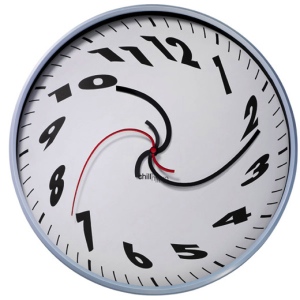
In 1922, the Artist Paul Klee completed a work entitled Die Zwitscher-Maschine, which has been translated into English as The Twittering Machine. The work is part of the Museum of Modern Art’s collection. The catalog description delves beneath the surface interpretation of a machine for making pleasant bird sounds:
Upon closer inspection, however, an uneasy sensation of looming menace begins to manifest itself. Composed of a wiry, nervous line, these creatures bear a resemblance to birds only in their beaks and feathered silhouettes; they appear closer to deformations of nature. The hand crank conjures up the idea that this “machine” is a music box, where the birds function as bait to lure victims to the pit over which the machine hovers. We can imagine the fiendish cacophony made by the shrieking birds, their legs drawn thin and taut as they strain against the machine to which they are fused.
I’d like to take a moment to delve beneath the surface of the machinery that makes up the micro-messaging ecosystem. The micro-messaging service Twitter approaches a kind of frictionless channel for messaging. Everything about it seems to be built for growth and speed. After the substantial speed bump of signing up and orienting yourself in the system, both listening for, and creating messages are very simple. Select the other people (and pseudo-people) you’d like to follow, type fewer than 140 characters of hypertext into a text field and press update.
It’s been noted many times that the follow social structure – the directed social graph – allows for the rapid expansion of social linking. A participant is able to follow many others without the requirement of reciprocity. I follow you, you don’t have to follow me. And the retweet has emerged as a method of transmitting messages across multiple overlapping social graphs. Hash tags have become a conventional method of indicating a message tied to a particular event. All of these tools are dedicated to the acceleration of the growth of the Twitter network. Twitter’s trending topics and search functionality allow users to find high-velocity memes as they begin to achieve broad circulation through the social mesh.
Examples of the benefits of the speed of the Twitter network abound – news about the earthquake in China, the plane landing on the Hudson River, reports on wild fires in Southern California, etc. The news media, feeling somewhat usurped here, has also brought the negative aspects of this lack of friction in the system. Usually this kind of story is meant to point to the filtering role of their own editorial facility. The New York Times put a Twitter contretemps involving Stephen Fry in the first section of their newspaper.
…that little tweet set off a frenzy of vitriolic attacks and counterattacks on Twitter, drawing an untold number of people into an increasingly charged debate and thrusting brumplum — in reality a man from Birmingham, England, named Richard — unhappily into the public’s angry glare. It was an example once again of the extraordinary power of Twitter to distribute information and to sway the opinions of vast groups of people in tiny amounts of time.
While the frictionless micro-messaging environment can accelerate important, or amusing, messages (news, stories, jokes, musings), it can also assemble and ignite an angry mob at lightning speed. And if we look at the tool set we’re offered, everything is oriented toward accelerating people, memes and the growth of the Twitter network. In this frame, value is equated with high velocity and numbers of retweets, likes, mentions, @replies, followers and now, list memberships. We’re looking for what, or who, is going viral.
But if we examine the often banal items that achieve virality, we have to question the value = virality equation. Often the high numbers are a result of lowest-common denominator dynamics, it’s not the cream rising to the top. There are certain kinds of viral items that we’d prefer to be vaccinated against. We’d like a micro-messaging Center for Disease Control warning us about time-wasting viral memes spreading through the Network. Where are the tools to retard the spread of a meme? Where’s the don’t like, or the visible gesture of hiding something from your messaging stream. It’s as though we’ve put a poll in the field that only asks for a positive response and excludes all negative reaction. Feedback loops require both positive and negative inputs.
Feedback is a mechanism, process or signal that is looped back to control a system within itself. Such a loop is called a feedback loop. Intuitively many systems have an obvious input and output; feeding back part of the output so as to increase the input is positive feedback; feeding back part of the output in such a way as to partially oppose the input is negative feedback.
Negative feedback helps to maintain stability in a system in spite of external changes. It is related to homeostasis. For example, in a population of foxes (predators) and rabbits (prey), an increase in the number of foxes will cause a reduction in the number of rabbits; the smaller rabbit population will sustain fewer foxes, and the fox population will fall back. In an electronic amplifier feeding back a negative copy of the output to the input will tend to cancel distortion, making the output a more accurate replica of the input signal.
Positive feedback amplifies possibilities of divergences (evolution, change of goals); it is the condition to change, evolution, growth; it gives the system the ability to access new points of equilibrium.
One method of judging the relative merit of the memes circulating through the stream is to pay close attention to the silences, the negative gestures. While the wisdom of crowds may have crowned an item the real-time meme of the moment, there’s a simple way to filter for value. Using a small portfolio (lists, if you will) of people who’s opinion you respect – look to see if they remain silent on a topic. In the task of discovering value, this kind of silence is golden.
In the early stages of growth, accelerants are essential. As a Network matures, unless it develops a deeper tool set, it simply becomes a twittering machine. The value it appears to create is illusory, and so the commons begins its descent to knee-jerk reactions to the high numbers generated by the lowest common denominator. Perhaps the inevitable result is that overlapping publics contract and the social space becomes a much more private circulatory system. The crucible of dispute, debate and dialogue that produces real value may only emerge away from the public network of accelerants where the social contract allows such differences (both positive and negative feedback). One of the better statements of this kind of contract was for the Nettime mailing list:
Nettime was vector for experimenting with net critique that would confront it with the possibility of inventing new forms of discourse and dialogue in a new medium. Consensus is not the goal. There’s no governing fantasy according to which the differences within this ‘group’ will on some ever-deferred day be resolved. the differences are Nettime; they might be dialectical, implying each other, or they might be differential, making absolutely no reference whatsoever to each others’ terms. Net critique, if understood as a shared practice in and against a never pre-defined techno-local environment, contains many modes of possible participation.
In navigating the electrical storms and fires of the micro-messaging Network, we’d do well to have some tools in our kit in addition to that can of gasoline.





